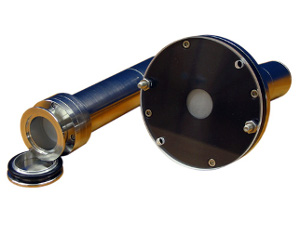
Model 658 End-on PMT Housing Assembly
The photomultiplier tube (PMT) is among the most popular photosensitive devices. Various tube types and scintillator treatments permit use of these detectors from the Extreme Vacuum Ultraviolet (EUV) through the Visible and into the near Infrared. They provide large photosensitive areas, secondary emission multiplication (high gain), low dark noise and fast time response. Photomultipliers are ideal for a broad range of spectroscopy applications. The Model 658 accommodates 28mm end on PMTs. All end-on photomultiplier housing assemblies are provided with a socket for a specified tube, tubes are specified separately. The housing has connectors for current output and high voltage (HV) input. Some models are equipped with scintillators for vacuum ultraviolet (VUV) operation. The scintillator converts invisible vacuum ultraviolet light to a Visible light emission, easily detected by sensitive PMTs. This detector housing assembly is available with 2.75" CF flange, NW40 Quik flange, and McPherson flange terminations.
Model 658 PMT Housing Assembly Data Sheet
See also PDF Sheet for the sodium salicylate scintillator and a guide to readily available coated windows
| Type | Range, nm | Peak, nm | Max. Vdc | Sensitivity, uA/lm | Typ Amplification | Rise Time | Transit Time |
| R6095 | 300 - 650 | 420 | 1500 | 88 | 2.1 x 10^6 | 4 ns | 30 ns |
| R374 | 185 - 850 | 420 | 1500 | 64 | 5.3 x 10^5 | 15 ns | 60 ns |
| Part Number | Description |
| 8105-0658-0 | Model 658 Atmospheric photomultiplier tube detector housing (for end-on 28mm dia tubes) with magnetic shielding, dynode network and socket. Requires PMT. Provided with a mounting flange fitting McPherson slits. |
| 8105-0658-1 | Model 658 Vacuum photomultiplier tube detector housing (for end-on 28mm dia tubes) with magnetic shielding, dynode network and socket. Requires PMT. Provided with a mounting flange fitting McPherson slits and a scintillator coated window for use in the vacuum ultraviolet. |
| 8105-0658-2 | Model 658 Vacuum photomultiplier tube detector housing (for end-on 28mm dia tubes) with magnetic shielding, dynode network and socket. Requires PMT. Provided with a ISO NW40KF flange and a scintillator coated window for use in the vacuum ultraviolet. |
| 100-110470 | Model 658 UHV photomultiplier tube detector housing (for end-on 28mm dia tubes) with magnetic shielding, dynode network and socket. Requires PMT. Provided with a DN40CF scintillator coated window flange for use in the vacuum ultraviolet and UHV. |
| 8446-1003-0 | Replacement Sodium Salicylate coated window for Model 658 |
| 8446-1003-0 | Replacement Sodium Salicylate coated window for ISO NW40KF terminated Model 658 |